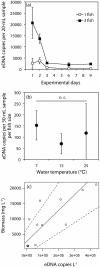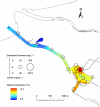Estimation of fish biomass using environmental DNA
- PMID: 22563411
- PMCID: PMC3338542
- DOI: 10.1371/journal.pone.0035868
Estimation of fish biomass using environmental DNA
Abstract
Environmental DNA (eDNA) from aquatic vertebrates has recently been used to estimate the presence of a species. We hypothesized that fish release DNA into the water at a rate commensurate with their biomass. Thus, the concentration of eDNA of a target species may be used to estimate the species biomass. We developed an eDNA method to estimate the biomass of common carp (Cyprinus carpio L.) using laboratory and field experiments. In the aquarium, the concentration of eDNA changed initially, but reached an equilibrium after 6 days. Temperature had no effect on eDNA concentrations in aquaria. The concentration of eDNA was positively correlated with carp biomass in both aquaria and experimental ponds. We used this method to estimate the biomass and distribution of carp in a natural freshwater lagoon. We demonstrated that the distribution of carp eDNA concentration was explained by water temperature. Our results suggest that biomass data estimated from eDNA concentration reflects the potential distribution of common carp in the natural environment. Measuring eDNA concentration offers a non-invasive, simple, and rapid method for estimating biomass. This method could inform management plans for the conservation of ecosystems.
Conflict of interest statement
Figures




Similar articles
-
Environmental DNA integrity index is sensitive for species biomass estimation in freshwater.Sci Total Environ. 2025 Feb 25;966:178734. doi: 10.1016/j.scitotenv.2025.178734. Epub 2025 Feb 5. Sci Total Environ. 2025. PMID: 39914319
-
The relationship between the distribution of common carp and their environmental DNA in a small lake.PLoS One. 2014 Nov 10;9(11):e112611. doi: 10.1371/journal.pone.0112611. eCollection 2014. PLoS One. 2014. PMID: 25383965 Free PMC article.
-
Use of droplet digital PCR for estimation of fish abundance and biomass in environmental DNA surveys.PLoS One. 2015 Mar 23;10(3):e0122763. doi: 10.1371/journal.pone.0122763. eCollection 2015. PLoS One. 2015. PMID: 25799582 Free PMC article.
-
Environmental conditions influence eDNA persistence in aquatic systems.Environ Sci Technol. 2014;48(3):1819-27. doi: 10.1021/es404734p. Epub 2014 Jan 21. Environ Sci Technol. 2014. PMID: 24422450 Review.
-
eDNA as a tool for identifying freshwater species in sustainable forestry: A critical review and potential future applications.Sci Total Environ. 2019 Feb 1;649:1157-1170. doi: 10.1016/j.scitotenv.2018.08.370. Epub 2018 Aug 28. Sci Total Environ. 2019. PMID: 30308887 Review.
Cited by
-
Mosquitoes on a chip-environmental DNA-based detection of invasive mosquito species using high-throughput real-time PCR.PeerJ. 2024 Sep 30;12:e17782. doi: 10.7717/peerj.17782. eCollection 2024. PeerJ. 2024. PMID: 39364359 Free PMC article.
-
Using eDNA sampling for species-specific fish detection in tropical oceanic samples: limitations and recommendations for future use.PeerJ. 2023 Feb 2;11:e14810. doi: 10.7717/peerj.14810. eCollection 2023. PeerJ. 2023. PMID: 36751629 Free PMC article.
-
Environmental DNA analysis as an emerging non-destructive method for plant biodiversity monitoring: a review.AoB Plants. 2022 Jul 2;14(4):plac031. doi: 10.1093/aobpla/plac031. eCollection 2022 Aug. AoB Plants. 2022. PMID: 35990516 Free PMC article. Review.
-
Detection of an invasive aquatic plant in natural water bodies using environmental DNA.PLoS One. 2019 Jul 12;14(7):e0219700. doi: 10.1371/journal.pone.0219700. eCollection 2019. PLoS One. 2019. PMID: 31299064 Free PMC article.
-
Exploring the relationship between environmental DNA concentration and biomass in Asian giant softshell turtle (Pelochelys cantorii).PeerJ. 2023 Oct 4;11:e16218. doi: 10.7717/peerj.16218. eCollection 2023. PeerJ. 2023. PMID: 37810767 Free PMC article.
References
-
- Begon M, Townsend CR, Harper JL. Ecology: from individuals to ecosystems. Hoboken, NJ, USA: Wiley-Blackwell; 2005. 752
-
- Valentini A, Pompanon F, Taberlet P. DNA barcoding for ecologists. Trends Ecol Evol. 2009;24:110–117. - PubMed
-
- Jerde CL, Mahon AR, Chadderton WL, Lodge DM. “Sight-unseen" detection of rare aquatic species using environmental DNA. Conserv Lett. 2011;4:150–157.
Publication types
MeSH terms
Substances
LinkOut - more resources
Full Text Sources
Research Materials

